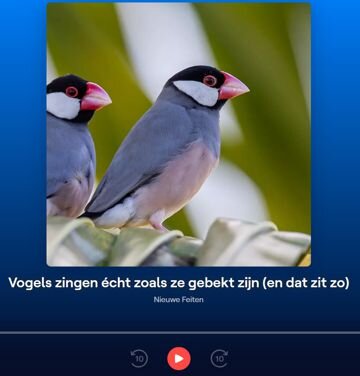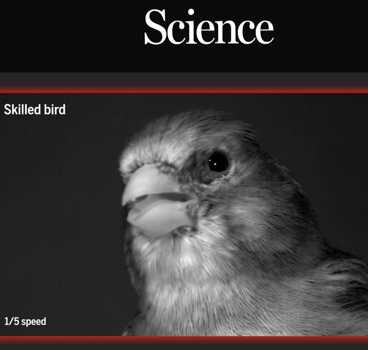2025: bird beaks and songs
National public radio interview with Sam on bird beaks in relation to songs and feeding, including reports on research at FunMorph (link to sound recording - in Dutch).

2023: Superstar seed crackers
Our research on the mechanics of seed cracking in canaries, running in collaboration with the BECO lab, got advertised on the Science website. The results of Tim Andries' PhD research, in which seed handling and skills are measured, are highlighted:

doi: 10.1126/science.adg6785
2023: Tales of the tongue
A news report on research on vertebrate tongues in Science (https://doi.org/10.1126/science.adi8563) featured interview snippets with Sam (full text PDF). This report was followed up by an article in Le Monde (PDF), and a radio interview at NBR Nieuwsradio (The Netherlands), which is also published as a podcast here (in Dutch).

2022: Woodpeckers minimise cranial absorption of shocks

We found that no shock absorption is taking place in the cranial skeleton of woodpeckers. Our work was published in Current Biology. It was featured on the cover of the July 2022 issue, that also included a synopsis by Prof. Andrew Biewener entitled “Physiology: Woodpecker skulls are not shock absorbers”.
Interviews and worldwide coverage by many media outlets followed. Here is a selection: [Belgium] VRT Nieuws, Het Laatste Nieuws, MSN België, De Morgen, De Standaard, [The Netherlands] Volkskrant, Scientias, PZC, Kijkmagazine, [Germany]Frankfurter Algemeine Zeitung, N-TV, Germanic News,Web.de, Bild Der Wissenschaft, Der Spiegel [Austria] Der Standard, Österreichischer Rundfunk, [Switzerland] UZwil24, [France] Science et Avenir, ReelNouvelles,NewsDay, Technologie Média, Revue Salamandre [India] NewsNCR, [Austrialia] Cosmos Magazine, [USA] Aboudon, Popular Science, The Atlantic, New Scientist, Science, Ars Technica, National Public Radio, Science Daily, Salon, Bird Informer, Newser, The New York Times, Scientific American, [UK] Daily Mail, Independent, The Times, [Italy], Science CUE, [Denmark] Illustreret Videnskab, [Norway] NRK,
Articles for a broad public were written by Maja for the November 2022 issue of Der Falke, by Sam for the July 2023 issue on Physics in Animals from the Nederlands Tijdschrift Voor Natuurkunde (PDF 8 MB), and by Sam and Maja for Physics Today published in their issue of Januari 2024 (PDF; HTML). Physics Today featured our story on the cover, and it was listed as their 'most read' article in January 2024:

Our findings triggered the writers of a book for children to adjust part of their story just in time before it was printed.
2022: The role of boxfish keels
2022: First views on 3D waterflow patterns inside the mouth of fishes
This is the first study to combine stereoscopic high-speed x-ray recordings with x-ray particle tracking to measure ‘invisible’ water flows in 3D (using 3D2YMOX). My team showed how fish use specific flow patterns inside their mouths to transport food. The results of our paper published in eLife, was covered in newspapers De Standaard (PDF of article in Dutch) including an interview with Sam and prof. David Lentink, in the 'Outside JEB' section of the Journal of Experimental Biology (link to article), and in Le Monde (PDF of article in French).

2021: Why lizards with longer hind legs catch more wind
A computer simulation analysis showed the downside for lizards living in regions with a high chance of hurricanes to have long hind limbs: they catch significantly more wind. The results of our paper, published in Functional Ecology, were covered in Outside JEB, and an interview with Sam appeared on the Functional Ecologists Blog. In April 2022, our research appeared in the nature documentary 'Cataclysmes, Les grands régulateurs'. The fragment of the documentary (in French; 6 minutes) featuring Anthony Herrel and Sam can be viewed here on Vimeo.

2021: Why woodpeckers don’t get stuck to trees

We discovered that the black woodpecker uses a special trick to facilitate retracting its beak after it got stuck in the wood. Several news outlets covered this story, including Science, De Standaard, Daily Mail, Deutsche Welle, The Times, Boingboing, News Break.
It was also featured on the popular TV quiz Wer weiss den sowas on one of the largest German stations ARD das Erste. The two-minute clip can be viewed here on Vimeo.
2020: How a square fish get around

We showed how the tail is helping boxfish to control their turning manoeuvres. The study was published in Royal Society Open Science, and was covered by The New York Times. Dutch television RTL4 covered our work, including an interview with lead author Pim Boute (youtube link to view this episode of '5 uur live')
2019: Catch and release hampers feeding performance in fish

We showed that holes in fishes' jaws caused by fishing hooks reduces their suction power, making it more difficult for them to capture food. The study was published in The Journal of Experimental Biology, and covered in a variety of news sources, including The Independent, iNews UK, Phys.org, Discovery Magazine, De Standaard, Gazet van Antwerpen, Radio Zuidrand, and CBC Radio.
2016: Tilapia parents churn to cough kids clear

Kathryn Knight from Inside JEB made an interview-report on my study on the kinematics of mouthbrooding in the Nile tilapia published in The Journal of Experimental Biology.
2015: The jaws of a four-eyed fish

We showed how the four-eyed fish Anableps anableps uses its protruding jaw to capture prey on land. The study was published in The Journal of Experimental Biology, and covered in the same journal (Inside JEB), and as a "Research Highlight" in Nature.
2015: A 'water tongue' to grab prey on land

We showed how water is used by mudskippers when they feed on land: Periophthalmus barbarus uses water as a tongue to aid in the capturing and intra-oral transporting of food. The study was published in Proceeding of the Royal Society B, and covered in Nature’s News , Science News, New Scientist, National Geographic, Scientific American and CBC Radio. In 2021, our discovery was also featured in an episode of Animalogic on youtube.
2015: Boxfish swimming paradox resolved

We showed that, contrary to previous claims, the shape of the bony carapace of boxfish does not cause course-stabilisation during swimming. Instead, the flow over the boxfish's body promotes manoevrability. The study was published in Journal of the Royal Society Interface (full article pdf), and was covered in Nature's News and Views section (pdf).
2014: Fish grind teeth to grunt

I helped making X-ray videos of sound-producing French Grunts that allowed a team led by Frédéric Bertucci of the University of Liége to locate the source of their gunting sounds: the grinding motions of the pharyngeal jaws. The study was published in the Journal of Experimental Biology (full article), and was covered as a research highlight in the same journal (inside JEB) as well as in Nature.
2013: Eating was tough for early tetrapods

This report in Science includes an interview about my work on terrestrial feeding in amphibous fishes. It was published following a symposium on water-to-land transitions at the SICB-conference in San Francisco, for which I was an invited speaker.
2011: Why seahorses resemble horses

I discovered an advantage of the horse-like properties of seahorses (their curved trunk and tilted head) for the way they capture their prey. The study was published in Nature Communications. A Youtube video made by the Nature editors summarises the article. The article was covered by Belgian television (ATV), local newspapers (Gazet Van Antwerpen, De Standaard)and many websites (BBC, NBCNEWS, LiveScience, Kennislink, The Guardian).
2006: Catfish strikes on land

We discovered that the eel-catfish (Channallabes apus), an inhabitant of the muddy swamps of tropical Africa, possesses the remarkable ability to forage and capture prey on land. The animal’s capacity to bend the head down towards the substrate while feeding terrestrially appears to be an essential feature for fishes to make the transition from an aquatic to a terrestrial feeding mode. The study was published in Nature, and covered by a long list of TV stations (VTM, Discovery Channel Canada, ATV), newspapers and magazines (De morgen (BE) , De Standaard (BE) ,Gazet Van Antwerpen (BE), Het Laatste Nieuws (BE), EOS (BE), Metro (BE), Kamagurka (BE), Berliner Zeitung (DE), Spiegel Online (DE), New York Times (USA)), and websites (VPRO (NL), BBC NEWS (UK), ORF.at (AT), 20 Minuten (CH), Tiede (FI), Elementy.ru (RU), Membrana (RU), Fox News (USA), NPR (USA), National Geographic (USA), Dajiyuan (CHINA), Wild Singapore (SINGAPORE)). The original article became the 6th most read article on the Nature website of the year 2006.
